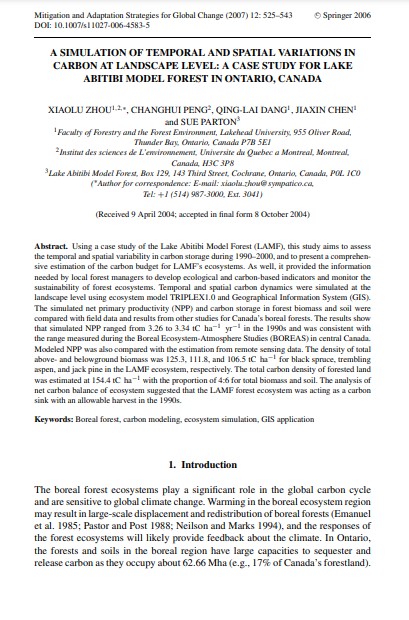Simulation of Temporal and Spatial Variations in Carbon at Landscape Level: A Case Study at Lake Abitibi Model Forest in Ontario, Canada
Bosque Modelo:
Lake Abitibi
Temática:
Gestión forestal
Tipo de documento:
Artículo científico
Resumen
Using a case study of the Lake Abitibi Model Forest (LAMF), this study aims to assess the temporal and spatial variability in carbon storage during 1990–2000, and to present a comprehensive estimation of the carbon budget for LAMF’s ecosystems. As well, it provided the information needed by local forest managers to develop ecological and carbon-based indicators and monitor the sustainability of forest ecosystems. Temporal and spatial carbon dynamics were simulated at the landscape level using ecosystem model TRIPLEX1.0 and Geographical Information System (GIS). The simulated net primary productivity (NPP) and carbon storage in forest biomass and soil were compared with field data and results from other studies for Canada’s boreal forests. The results show that simulated NPP ranged from 3.26 to 3.34 tC ha−1 yr−1 in the 1990s and was consistent with the range measured during the Boreal Ecosystem-Atmosphere Studies (BOREAS) in central Canada. Modeled NPP was also compared with the estimation from remote sensing data. The density of total above- and belowground biomass was 125.3, 111.8, and 106.5 tC ha−1 for black spruce, trembling aspen, and jack pine in the LAMF ecosystem, respectively. The total carbon density of forested land was estimated at 154.4 tC ha−1 with the proportion of 4:6 for total biomass and soil. The analysis of net carbon balance of ecosystem suggested that the LAMF forest ecosystem was acting as a carbon sink with an allowable harvest in the 1990s.
Información Bibliográfica
Autor:
Zhou, X, CH Peng, QL Dang, JX Chen and S Parton.
Revista:
Mitigation and Adaptation Strategies for Global Change
Año:
2007
N°:
4
País :
Canadá
Páginas:
525 - 543
Volumen:
12
Idioma:
Ingles
Palabras claves
Boreal forest, carbon modeling, ecosystem simulation, GIS application





